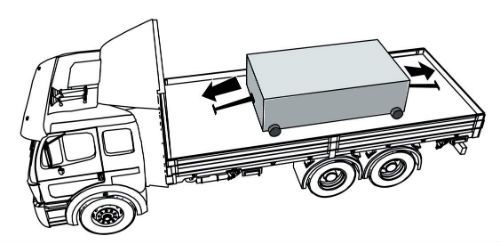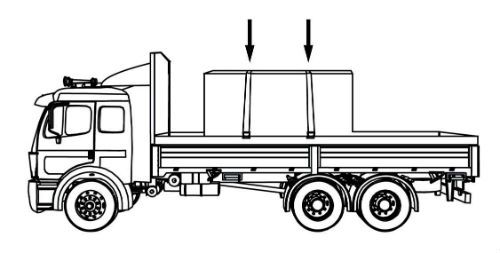CDL Practice Tests: Flatbed Cargo Securement
Choose A Section:
Go!What is the maximum weight that can be secured by a tiedown with a marked WLL of 5,000 lbs?
- 2,500 lbs
- 5,000 lbs
- 6,000 lbs
- 10,000 lbs
Note: The minimum WLL requirement for the securement system is 50%. More tiedown capacity should be used if you need to secure an article against any movement.
A tiedown is defined as:
- A rail along the side of a vehicle that protects the side of the vehicle from impacts.
- A combination of securing devices which form an assembly that attaches cargo to, or restrains cargo on, a vehicle or trailer, and is attached to anchor point(s).
- A structure, device, or another substantial article placed against or around an article to prevent horizontal movement of the article.
- A strip of material that may be used to unitize articles and is tensioned and clamped or crimped back upon itself. (same as "Strapping")
Tiedown:
A combination of securing devices which form an assembly that attaches cargo to, or restrains cargo on, a vehicle or trailer, and is attached to anchor point(s).
When securing paper rolls with friction mats as a primary method:
- The friction mat should stick out from underneath the roll in the direction it is providing securement.
- All of these answers.
- The friction mat should stick out from underneath the roll in the opposite direction for which it is providing securement.
- Make sure friction mats are completely covered by the roll.
Requirements for friction mats

If a friction mat is used to provide the principal securement for a paper roll, insert the friction mat so that it sticks out from beneath the footprint of the roll in the direction in which it is providing securement.
A sided vehicle containing cargo weighing 35,980 lbs must be able to withstand a rearward force of at least:
- 17,990 lbs
- 28,784 lbs
- 36,000 lbs
- 10,000 lbs
Note: If the cargo is contained in a sided vehicle, the vehicle structure MUST be strong enough to withstand the forces described earlier.
- Forward force: 0.8 g (80%)
- Rearward force: 0.5.g (50%)
- Sideways force: 0.5 g (50%)
In cargo securement, what is a 'cleat' defined as?
- A short piece of material, usually wood, nailed to the deck to reinforce blocking.
- A tapered piece of material, thick at one end and thin at the other.
- Part of the structure, fitting, or attachment on a vehicle or cargo to which a tiedown is attached.
- A tapered or wedge-shaped piece used to secure round articles against rolling.
Cleat:
A short piece of material, usually wood, nailed to the deck to reinforce blocking.
A bulkhead is defined as:
- A vertical barrier across a vehicle to prevent forward movement of cargo.
- A vertical barrier placed directly behind the cab of a tractor to protect the cab in the event cargo should shift forward.
- A structure, device, or another substantial article placed against or around an article to prevent horizontal movement of the article.
- A vertical barrier across the front of the deck of a vehicle to prevent forward movement of cargo.
Bulkhead:
A vertical barrier across a vehicle to prevent forward movement of cargo.
As part of their pre-trip cargo securement inspection, drivers should:
- Inform carrier of any inadequate packaging.
- All of these apply.
- Check for anything that will obscure their vision.
- Make sure cargo is properly secured.
Driver inspection checklist:
Pre-Trip
- Make sure that cargo is properly distributed and adequately secured (in other words, according to the Standard).
- Make sure that all securement equipment and vehicle structures are in good working order and used consistent with their capability.
- Stow vehicle equipment.
- Make sure that nothing obscures front and side views or interferes with the ability to drive the vehicle or respond in an emergency.
-
Inform carrier if packaging is not adequate. For example:
- Banding is loose or not symmetrical on package.
- Banding attachment device(s) are inefficient.
- Wrapping is broken or ineffective.
- Pallets are broken.
Option #1 for securing coils transported with eyes lengthwise includes:
- It should include all of these things
- Using blocking or friction mats to prevent forward movement.
- Attaching at least one tiedown diagonally from the left side of the vehicle, through the eye, to the right side of the vehicle
- Attaching at least one tiedown diagonally from the right side of the vehicle, through the eye, to the left side of the vehicle
Tiedowns, Single Coil Option #1
Attach at least one tiedown diagonally from the left side of the vehicle, through the eye, to the right side of the vehicle. If possible, the angle between the tiedown and the deck should be less than 45, when viewed from the side of the vehicle.
Attach at least one tiedown diagonally from the right side of the vehicle, through the eye, to the left side of the vehicle. If possible, the angle between the tiedown and the deck should be less than 45, when viewed from the side of the vehicle.

Attach at least one tiedown side-to-side over the top of the coil.
Use blocking or friction mats to prevent forward movement.
When securing concrete pipe up to 45 inches loaded crosswise, tiedowns through the pipe must be:
- Nylon rope.
- Chains
- Straps.
- Wire.
Tiedown requirements
- Pipe may be secured individually or as a group.
- Tiedowns through the pipe must be chains.
- Front-to-back tiedowns may be chain or wire rope.
What is bell pipe concrete?
- Concrete used to make bell pipe.
- Pipe used to make concrete bells.
- Pipe whose flanged end is of larger diameter than its barrel.
- Pipe whose flanged end is of smaller diameter than its barrel.
Bell Pipe Concrete:
Pipe whose flanged end is of larger diameter than its barrel.
About The Flatbed Cargo Securement CDL Manual
Studying the flatbed cargo securement CDL manual is not a requirement for getting your CDL permit or license. It is required knowledge for flatbed drivers.
Some questions you should be able to answer for flatbed cargo securement:
- What is the minimum Working Load Limit of a tiedown used to secure logs?
- What is the minimum weight of a shipment of paper rolls that would require specific securement requirements?
- When securing concrete pipe over 45 inches loaded crosswise, which direction must the tiedowns on the front half of the load run?
- What is a cab shield?
- When securing concrete pipe over 45 inches loaded crosswise, which direction must the tiedowns on the rear half of the load run?
- What is a dunnage bag?
- Who is responsible for inspecting securing devices and cargo within the first 50 miles?
- How many tiedowns are required on a stack of shortwood loaded crosswise?
- What is the minimum working load limit of each tiedown used to secure crushed or flattened vehicles?
- Define 'bolster'
- What is a hook-lift container?
- When a tiedown is attached directly to the cargo, what is the ideal angle where it attached to the vehicle?
What is a securing device?
Any device specifically manufactured to attach or secure cargo to a vehicle or trailer:
- Synthetic Webbing
- Chain
- Wire rope
- Manila rope
- Synthetic rope
- Steel strapping
- Clamps and latches
- Blocking
- Front-end structure
- Grab hooks
- Binders
- Shackles
- Winches
- Stake pockets
- D-rings
- Webbing ratchet
- Bracing
- Friction mat
What is a tiedown?
A combination of securing devices that forms an assembly that:
- Attaches cargo to, or restrains cargo on a vehicle.
- Is attached to anchor point(s).

Some tiedowns are attached to the cargo and provide direct resistance to restrain the cargo from movement.

Some tie-downs pass over or through the cargo. They create a downward force that increases the effect of friction between the cargo and the deck. This friction restrains the cargo.
 Related Cargo Securement Terms That Every Driver Should Know:
Related Cargo Securement Terms That Every Driver Should Know:
-
Tiedown:
A combination of securing devices which form an assembly that attaches cargo to, or restrains cargo on, a vehicle or trailer, and is attached to anchor point(s).
-
Contained:
Cargo is contained if it fills a sided vehicle, and every article is in contact with or sufficiently close to a wall or other articles so that it cannot shift or tip if those other articles are also unable to shift or tip.
-
Blocking:
A structure, device, or another substantial article placed against or around an article to prevent horizontal movement of the article.
How should tiedowns be attached?
Tiedowns can be used in two ways:
-
Attached to the cargo:
- Tiedowns attached to the vehicle and attached to the cargo.
- Tiedowns attached to the vehicle, pass through or aroundan article of cargo, and then are attached to the vehicle again.
-
Pass over the cargo:
- Tiedowns attached to the vehicle, passed over the cargo, and then attached to the vehicle again.
Tiedown placement:

Place the tiedown as close as possible to the spacer.
Position the tiedowns as symetrically as possible over the length of the article.

Position the tiedowns to preserve the integrity of the article.







 TT On Facebook
TT On Facebook